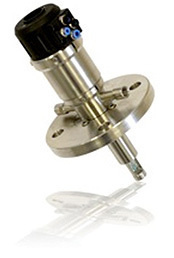A pH electrode is as good as its maintenance. This is especially true in harsh environments, the pH electrode needs being looked after or the measurement will give a serious source of concern. The installation needs frequent maintenance and therefore laborious interventions.
A true solution for these kinds of applications is automated support shaped into a retractable fitting with cleaning options. Yokogawa has created a distinct profile for oneself to be a solution provider regardless the application. To be able to live up to this profile Yokogawa has always looked for "the best" in the market and with these retractable fittings we feel –once again – that our range of retractable fittings will bring more solutions.
Details
 |
 |
 |
| The retractable holder EXAtrac RF20 (Extract 810 and 820) available in plastic, stainless steel and Alloy C22; is made for installation of 12mm sensors on tanks or pipelines where the sensor has to be removed without interruptions or shutdowns and in the hash applications where frequent cleaning is of vital importance for a good pH measurement. | The control unit RF20C (EXmatic 460) can fully and automatically control and supervise the measuring- and cleaning cycles of a pneumatic retractable fitting. The cleaning- and measuring intervals, starting signals can be set and changed to the process requirements. | The RF20M (EXmatic 450) is a pneumatic control unit for retractable fittings such as the RF20H (EXtract 810 and 820). It is Suitable for hazardous area |
Ressources
Current trend for increasing mercury awareness throughout the public sector has caused the government to take action. Recently, the Environmental Protection Agency (EPA) has focused their efforts on controlling mercury levels produced in various coal fired power plants. Based on information from several case studies, the EPA developed the Mercury and Air Toxics Standards to cut back mercury emissions. The most popular technology utilized by coal plants to meet the new standards is a scrubber which cleans the off gas from the combustion process. ORP sensors can further monitor the effluent from these scrubbers to ensure optimal mercury emission levels are achieved. By closely monitoring the mercury concentrations in the effluent, plant managers will be able to easily confirm their plants are meeting the EPA's standards.
Rechercher plus d'informations sur nos compétences, technologies et solutions
Contactez-nous
